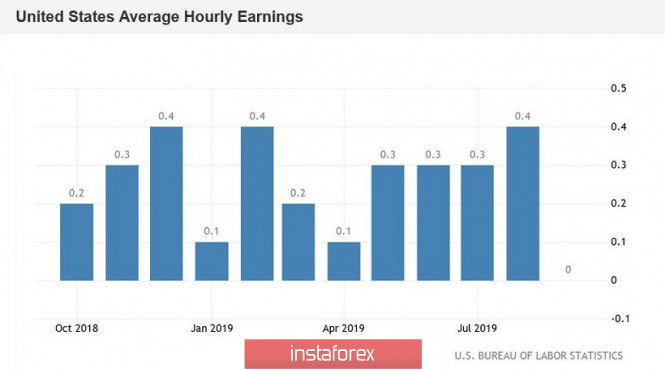US labor market data have been very controversial. On the one hand, the unemployment rate unexpectedly fell to record-low levels, while the increase in the number of people employed in the non-agricultural sector came out in the "red zone", not reaching the forecast values. After hesitating, the market nevertheless decided that "the glass is half full," and not vice versa, after which the dollar began to be in high demand. However, according to the results of the Nonfarm release, there are no winners or losers: the bears could not pull the pair into the region of the eighth figure, while the bulls could only approach the resistance level of 1.1000 (the middle line of the Bollinger Bands on the daily chart, coinciding with the Kijun- sen indicator Ichimoku). By and large, the EUR/USD pair remained in the same positions as before the release. The published data could not fundamentally reverse the fundamental picture for the pair, although in my opinion, they are clearly not in favor of the US currency.

Almost all components came out worse than expected, reflecting a slowdown in the labor market. Only the unemployment rate surprised with an unexpected decline to the level of 3.5%. This is a record of several decades - the last time the indicator was at this level in the distant 1969. However, this fact actually serves as little comfort for dollar bulls. The unemployment rate is not responding so quickly to the current situation - this indicator refers to lagging economic indicators. Therefore, a certain optimism of dollar bulls is premature, since more operational indicators indicate quite alarming trends.
Why did EUR/USD traders actually ignore the frankly weak Nonfarm? In my opinion, there are several reasons for this. Firstly, market participants were ready to reduce the labor market, after the publication of a weak report from the analytical agency ADP. According to them, the number of jobs in private US companies grew by only 135 thousand in September - this is the worst result since May of this year. This report was a kind of harbinger of weak Nonfarm. For example, a month ago, the number of people employed in the non-agricultural sector increased 145 thousand (before the revision), while the ADP report showed an increase in the number of employees in 157 thousand.
A high level of correlation of these indicators warned market participants that official numbers in September may be below forecast values. And so it happened: instead of an increase of 145 thousand (consensus forecast), the indicator grew by 136 thousand. The number of people employed in the private sector of the economy grew by only 114 thousand, while the forecast was at the level of 130 thousand. But the number of jobs in the manufacturing industry has declined altogether (by two thousand) - for the first time since April this year. It is worth recalling that the ISM production index has been consistently decreasing for the past 6 (!) Months, collapsing in September to the level of 47.8 points (10-year low). The share of economically active population also slightly fell - to 63.2%. In this case, the decline is minimal, but still played a role, given the dynamics of other indicators.
Nonfarm's inflationary component — the level of average hourly wages — was especially disappointing. This most important indicator for the Federal Reserve turned out to be zero on a monthly basis (the worst result since November 2017) and 2.9% on an annual basis (worst result since September 2018). Such dynamics are also correlated with the uncertain growth of key inflation indicators.

It is worth noting here that the labor market has long been a reliable tool for the dollar. Amid fluctuations in other key indicators, Nonfarm always supported dollar bulls - after the spring recession, the US labor market recovered and kept the mark for several months. But the numbers published yesterday amid a consistent decline in the ISM manufacturing index significantly spoiled the overall fundamental picture for the US currency. But the market ignored this fact, justifying the decline with temporary factors.
Fed Chairman Jerome Powell also "played up" to the dollar bulls. Speaking at a hearing in Washington last night, he voiced the most diplomatic position, maintaining his own rhetoric balance. On the one hand, he said that the US economy is in "good shape", the unemployment rate has reached a 50-year low, and inflation is striving to achieve its target. On the other hand, Powell recalled the "multiple risks" facing the US economy. First of all, we are talking about a slowdown in the global economy amid ongoing trade conflicts on a global scale. Having thus played the role of a "good and evil policeman" in one person, the head of the Fed, in fact, did not say anything definite - the dollar pairs after his speech remained at their previous price positions.
Thus, the market turned over the page of last week, ignoring the alarming, in my opinion, signals. Jerome Powell, in turn, did not escalate the situation, thereby confirming the "correctness" of the market reaction. Therefore, now all the attention of the foreign exchange market will be focused on trade negotiations between the US and China, which should start on October 10-12. Their results will determine the further vector of the movement of the US currency. In the meantime, EUR/USD traders are again forced to hang out in the flat: bears will pull the pair to the lower boundary of the price range (1.0890 is the lower line of the Bollinger Bands indicator on the daily chart), while buyers will rush to the "ceiling" of this band, then there is to the mark of 1.1080 (the lower boundary of the Kumo cloud, the Bollinger Bands indicator on the same timeframe coinciding with the upper line). But it will be possible to break out of this range only following the results of the fateful trade negotiations.
The material has been provided by InstaForex Company - www.instaforex.com